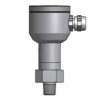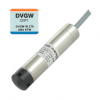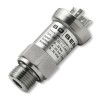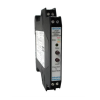Why we mainly use 4-20 mA current and 3-15 psig pressure and not use from zero to 20 mA or 15 psig?
For 4-20mA devices there is a single loop which is used to provide the signal and power to the device. If the signal was zero then there would be nothing powering the device. 0-4mA is used to power the device.
If you have an offset signal at zero reading it is good for failure mode indication: If the signal is 0 mA or 0 psi then there is fault with the equipment.
For a pneumatic 3-15 psi signal it is difficult to control very low pressures accurately with a simple regulator, plus you have to provide vacuum to allow for calibration and measurement hysteresis & repeatability errors.
Featured 4-20ma signal related products
 4-20mA Output Pressure Sensors - Find reliable pressure sensors with 4-20mA current loop outputs. Designed for demanding industrial applications, offering excellent noise immunity and simplified 2-wire installation for process monitoring.
4-20mA Output Pressure Sensors - Find reliable pressure sensors with 4-20mA current loop outputs. Designed for demanding industrial applications, offering excellent noise immunity and simplified 2-wire installation for process monitoring. LMP307 Submersible Level Transmitter - Submersible level transmitter for measuring liquid level with a 4-20mA current loop or a 0-10V voltage output plus optional ATEX approval for intrinsically safe use in hazardous areas in ranges from 1mH2O up to 250mH2O. The LMP307 is suitable for use on potable water with no leaching, and can be supplied with a drinking water certificate according to DVGW and KTW.
LMP307 Submersible Level Transmitter - Submersible level transmitter for measuring liquid level with a 4-20mA current loop or a 0-10V voltage output plus optional ATEX approval for intrinsically safe use in hazardous areas in ranges from 1mH2O up to 250mH2O. The LMP307 is suitable for use on potable water with no leaching, and can be supplied with a drinking water certificate according to DVGW and KTW.
Advantages of 4-20 mA vs 0-20 mA
- Using 2 instead of 3/4 wires reduces cost of wiring
- Power supply and signal circuit is combined into one
- Distinguish between zero signal and a fault
- Zero offset can be adjusted without need for polarity change of signal
Advantages of 3-15 psi vs 0-15 psi
- Easier to regulate pressure from 3 psi
- No need to provide vacuum when regulating zero signal at 3 psi
- Distinguish between zero pneumatic signal and a pressure failure
Featured 0-20ma signal related products
 DMP331 Precision Pressure Transmitter - Stainless steel pressure transmitter with ranges from 100mbar up to 40 bar gauge or absolute. Special options for ATEX , SIL2 and compound ranges.
DMP331 Precision Pressure Transmitter - Stainless steel pressure transmitter with ranges from 100mbar up to 40 bar gauge or absolute. Special options for ATEX , SIL2 and compound ranges. Universal Strain Gauge Bridge Input Transmitter – STRAIN - Simplify your strain measurement setup with the STRAIN Universal Strain Gauge Bridge Input Transmitter. This versatile device converts mV signals from strain gauges, load cells, and pressure transducers into 0-10Vdc, 0-20mA, or 4-20mA outputs.
Universal Strain Gauge Bridge Input Transmitter – STRAIN - Simplify your strain measurement setup with the STRAIN Universal Strain Gauge Bridge Input Transmitter. This versatile device converts mV signals from strain gauges, load cells, and pressure transducers into 0-10Vdc, 0-20mA, or 4-20mA outputs.
Related Help Guides
- Choosing calibrator for pressure transmitters
- Advantages and Disadvantages of using a 4 to 20 mA Signal
- How to create a list of specification parameters for a pressure sensor
- How do you measure flow rate with a dp cell
- Supply voltage and load resistance considerations for pressure transmitters
- How to Connect a 4-20mA Current Loop Pressure Transmitter
- Transforming a 2 wire Current Loop into a Voltage Output Signal
- How to get a 10 volt signal from a 4-20mA output pressure sensor
- What is the difference between a pressure transducer and a transmitter
Related Technical Terms
- 2 Wire
- 4 to 20 mA Current Loop Output Signal
- HART®
- Square Root Extraction
- Stainless Steel Pressure Sensors
- Transmitter
- Turndown Ratio
Related Online Tools
- Pressure Transmitter 4-20mA Current Output Calculator
- Flow Transmitter 4-20mA Current Output Calculator
- DP Flow Transmitter Output Calculator
- 4-20mA Signal to Measurement Reading Converter
- SqRt Extraction 4-20mA Signal to Measurement Reading Converter
- Temperature Transmitter 4-20mA Current Output Calculator
- Liquid Level Transmitter 4-20mA Current Output Calculator
- 0-20mA Signal to Measurement Reading Converter
- 4 to 20 mA Supply, Load, Shunt and Signal Calculator
- Pressure Transmitter 0-20mA Current Output Calculator
Related Application Questions and Answers
- 16 bar, 200°C steam pressure transmitter and gauge
- 4 x 4-20mA Signal Wireless Repeater
- Atmospheric range for 4-20mA pressure sensor
- All-In-One transmitter for measuring steam temperature to 150°C and pressure to 4kg/cm² g
- Vacuum suction sensor & wall mount digital readout with switched contacts
- Stainless steel 316L wetted parts 100 mbar ATEX pressure transmitter
- 5 to 20 psi absolute ambient 4 to 20 ma pressure transmitter
- Water temperature depth sensor for cooling tower sump
- Solvent compatible +/-100mWG dp transmitter with PTFE seals
- Vacuum pump inlet to outlet differential pressure sensor with 1500 Torr range
- Powder filter blockage monitoring pressure transmitter
- 300 F protected 100 psi pressure transmitter
Contact us about this Why use 4-20mA and 3-15 psi rather than 0-20mA & 0-15psi page to request more information, or to discuss your application requirements.
